Sabari River
| Sabari (శబరి నది) | |
| River | |
 Sabari river merging into Godavari near Kunavaram | |
| Country | India |
|---|---|
| States | Odisha, Chhattisgarh, Andhra Pradesh |
| Tributaries | |
| - left | Sileru River, Pateru River |
| Source | Sinkaram hill ranges |
| - elevation | 1,370 m (4,495 ft) |
| - coordinates | 18°N 82°E / 18°N 82°E |
| Mouth | Godavari River |
| - location | Kunavaram, Andhra Pradesh |
| - elevation | 25.3 m (83 ft) |
| - coordinates | 17°34′13″N 81°15′37″E / 17.57028°N 81.26028°ECoordinates: 17°34′13″N 81°15′37″E / 17.57028°N 81.26028°E |
| Length | 418 km (260 mi) |
| Basin | 20,427 km2 (7,887 sq mi) |
Sabari River (Telugu: శబరి నది) is one of the main tributaries of Godavari. It originates from the western slopes of Eastern Ghats in Odisha state from Sinkaram hill ranges at 1370 m MSL.[1] It is also known as Kolab river in Odisha.The Sabari river basin receives nearly 1250 mm annual average rainfall. It forms common boundary between Chhattisgarh and Odisha states and later enters into Andhra Pradesh to merge with River Godavari.[2] Upper Kolab project, located in Odisha across the Sabari is a major dam project supplying water for irrigation and Hydro power generation.
The 200 km long stretch of the river forming boundary between Chhattisgarh and Odisha drops by 2.25 meters per km length on average. This stretch of the river has substantial hydro electricity generation potential by building medium head (< 20 m) barrages in series to minimize land submergence.[3][4][5] The surplus water of Indravati River in Odisha can also be diverted to Sabari river via Jaura Nallah through which Indravati flood waters naturally overflow into Sabari basin.
Sileru River (known as Machkund in its upper reaches) is the major tributary of Sabari which joins Sabari river at tri-junction boundary point of Andhra Pradesh, Chhattisgarh and Odisha. Sileru river has huge potential of hydro electricity generation which has been substantially harnessed by constructing Machkund, Balimela, upper Sileru, Donkarayi and lower Sileru hydro power projects.
See also
References
- ↑ "Godavari river basin map"
- ↑ Sabari in spate
- ↑ "Middle Kolab project, Odisha state". Retrieved 23 July 2013.
- ↑ "PFR studies of Lower Kolab HE project" (PDF). Retrieved April 29, 2013.
- ↑ "CDM application for 25 mw Middle and 12 mw Lower Kolab Hydroelectric Projects" (PDF). Retrieved April 29, 2013.






